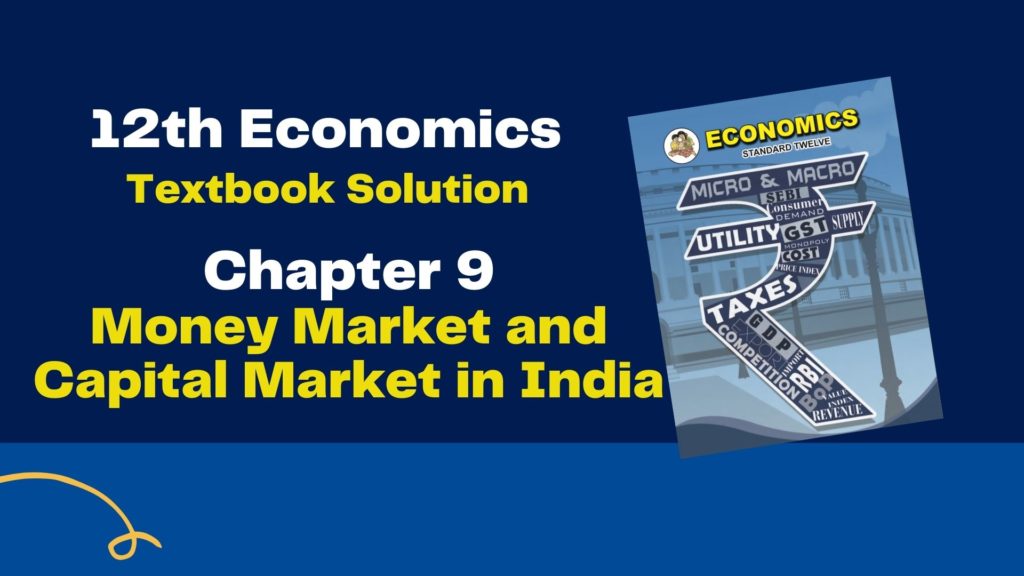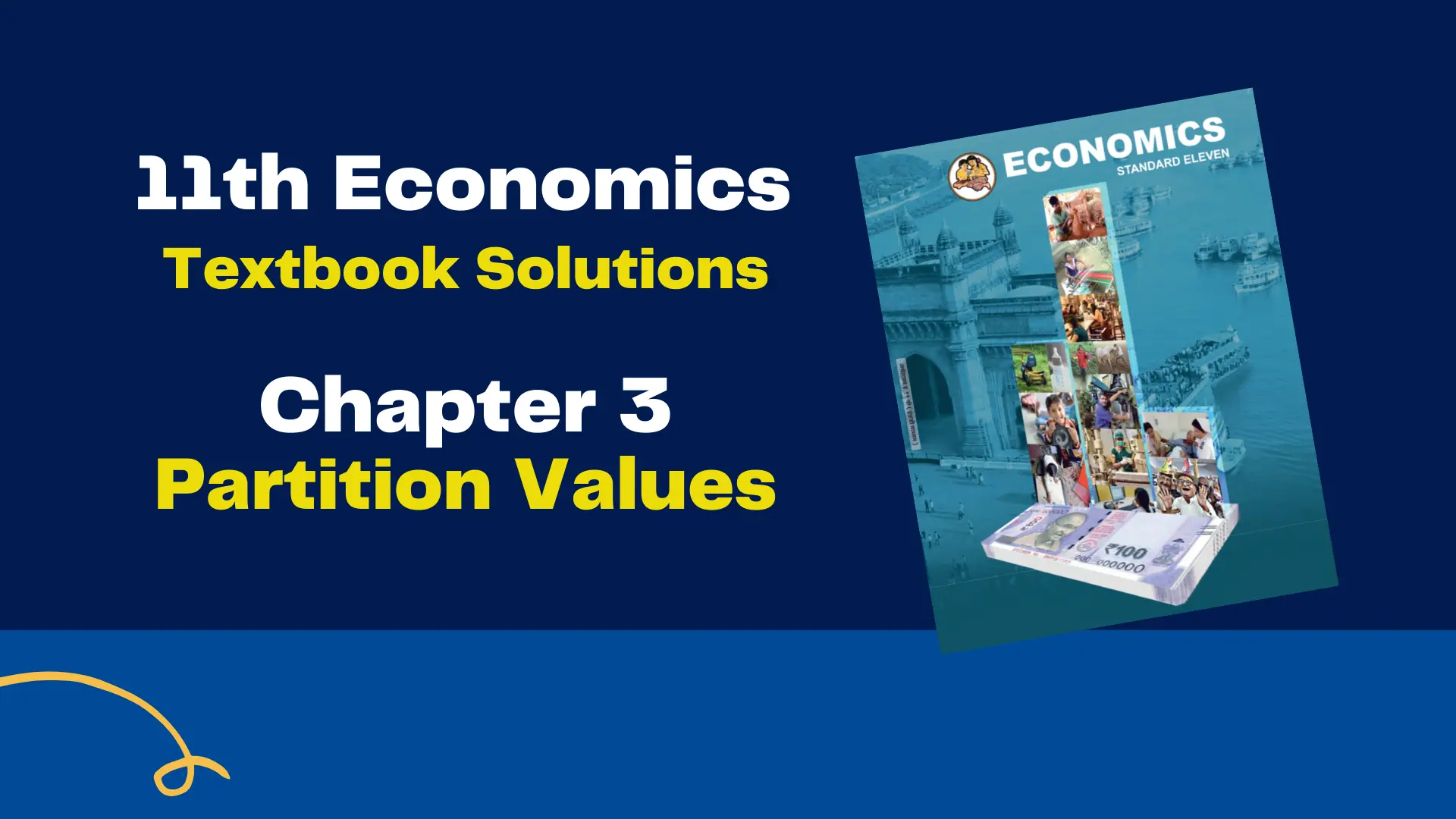12th Economics Chapter 9 Solutions (Money Market and Capital Market in India) Maharashtra Board – Free Solution
Table of Contents
12th Economics Chapter 9 Solutions

Chapter 9 – Money Market and Capital Market in India
Q. 1. Complete the following statements
1) Development financial institutions were established to ………….
a) provide short term funds.
b) develop industry, agriculture and other key sectors.
c) regulate the money market.
d) regulate the capital market.
2) Money market faces shortage of funds due to ………..
a) inadequate savings.
b) growing demand for cash.
c) presence of unorganized sector.
d) financial mismanagement.
3) Individual investors have lost confidence in the capital market due to ………..
a) lack of financial instruments.
b) high transaction costs.
c) low returns.
d) financial scams.
4) Commercial banks act as intermediaries in the financial system to ………..
a) make profits
b) accelerate the country’s economic growth.
c) mobilize the savings and allocating them to various sectors of the economy.
d) control the credit.
Q. 2. Complete the correlation
1) Money market : Short term funds : : Capital Market : Long term funds
2) RBI : Central Bank : : SBI : Commercial Bank
3) Co-operative banks : Organized sector : : Indigenous bankers : Unorganised sector
4) Primary market : New issues : : Secondary market : Old issues
Q. 3. Find the odd word
1) Types of Bank Accounts: Saving a/c, D-mat a/c, Recurring a/c, Current a/c
2) Unregulated Financial intermediates: Mutual fund, Nidhi, Chit fund, Loan Companies
3) Financial Assets: Bonds, Land, Govt. Securities, Derivatives
4) Quantitative Tools: Bank rate, Open market operations, Foreign Exchange rate, Variable reserve ratios
Solution of other subjects
Solution of all Chapters of Economics
1 – 2 – 3A – 3B – 4 – 5 – 6 – 7 – 8 – 9 – 10
Q. 4. Assertion and Reasoning
1) Assertion (A): Money market economizes use of cash
Reasoning (R): Money market deals with financial instruments that are close substitutes of money.
Options:
1) (A) is True, but (R) is False
2) (A) is False, but (R) is True
3) Both (A) and (R) are True and (R) is the correct explanation of (A)
4) Both (A) and (R) are True and (R) is not the correct explanation of (A)
2) Assertion (A): Regional stock exchanges have witnessed a sharp decline in the volume of trade.
Reasoning (R): Investors prefer to trade in securities listed in premier stock exchanges like BSE, NSE etc.
Options:
1) (A) is True, but (R) is False
2) (A) is False, but (R) is True
3) Both (A) and (R) are True and (R) is the correct explanation of (A)
4) Both (A) and (R) are True and (R) is not the correct explanation of (A)
3) Assertion (A): The unorganized sector of the money market lacks transparency.
Reasoning (R): Activities of the unorganized sector are largely confined to rural areas.
Options:
1) (A) is True, but (R) is False
2) (A) is False, but (R) is True
3) Both (A) and (R) are True and (R) is the correct explanation of (A)
4) Both (A) and (R) are True and (R) is not the correct explanation of (A)
4) Assertion (A): Foreign exchange management and control is undertaken by commercial banks.
Reasoning (R): RBI has to maintain the official rate of exchange of rupee and ensure its stability.
Options:
1) (A) is True, but (R) is False
2) (A) is False, but (R) is True
3) Both (A) and (R) are True and (R) is the correct explanation of (A)
4) Both (A) and (R) are True and (R) is not the correct explanation of (A)
Q. 5. Identify and explain the concepts from the given illustrations
1) Raghu’s father regularly invests his money in stocks and bonds.
Identified Concept: Investment in Stock Market.
Explanation: Stock exchange is an important constituent of the capital market. It is an association or organization in which stocks, bonds, commodities, etc are traded.
2) Sara makes a monthly contribution to a fund jointly created by her friends. The collected fund is then given to a chosen member through a lucky draw.
Identified Concept: Chit funds.
Explanation: Under Chit funds, members make a regular contribution to the fund. Bids or draws are made on the basis of criteria mutually agreed upon by the members. Accordingly, the collected fund is given to the chosen member.
3) Tina deposited a lump sum amount of Rs 50,000 in the bank for a period of one year.
Identified Concept: Fixed Deposit.
Explanation: Fixed deposits refer to a lumpsum amount deposited by a customer for a specified period of time. Compared to all other deposits, fixed deposits carry a high rate of interest.
4) ABC bank provides d-mat facility, safe deposit lockers, internet banking facilities to its customers.
Identified Concept: Ancillary functions of Commercial banks.
Explanation: Commercial banks also provide a range of ancillary services such as transfer of funds, collection of money, making periodical payments on behalf of the customer, merchant banking, foreign exchange, safe deposit lockers, D-mat facility, internet banking, mobile banking, etc.
Solution of other subjects
Solution of all Chapters of Economics
1 – 2 – 3A – 3B – 4 – 5 – 6 – 7 – 8 – 9 – 10
Q.6. Distinguish between
1) Money market and Capital market.
| Points | Money Market | Capital Market |
| 1)Meaning | Money market is a market for lending and borrowing of short-term funds. | Capital market is a market for long-term funds both equity and debt raised within and outside the country. |
| 2) Financial Instruments | Short term instruments such as trade bills, government securities, promissory notes, etc. | Shares, Debentures, Bonds, Retained Earnings, etc. |
| 3) Liquidity | Such instruments are highly liquid, less risky, and easily marketable with a maturity period of one year or less than one year. | Such instruments are less liquid, more risky as compared to money market with a Maturity period of more than one year. |
2) Demand deposit and Time deposit.
| Points | Demand Deposit | Time Deposit |
| 1) Meaning | Deposits that are withdrawable on demand are known as demand deposits. | Deposits that are repayable after a certain period of time are known as time deposits. |
| 2) Types | Saving accounts and Current accounts are the types of demand deposits. | Recurring deposits and Fixed deposits are the types of time deposits. |
3) Organized sector and Unorganized sector of money market.
| Points | Organized Sector of Money Market | Unorganized Sector of Money Market |
| 1)Meaning | The sector formed by the components of money market that comes under the direct control and supervision of the RBI is the organized sector of the money market. | The sector formed by the components of money market that are not under the direct control and supervision of the RBI is the unorganized sector of the money market. |
| 2) Rate of Interest | In this sector, financing is available to borrowers at a relatively low rate of interest. | In this sector, financing is available to borrowers at a relatively high rate of interest. |
Q.7. Answer the following
1) Explain the problems faced by the money market in India.
Answer: Compared to advanced countries, the Indian money market is less developed in terms of volume and liquidity. The following points explain the problems of the Indian Money Market :
1) Dual Structure of the Money Market:
The presence of both, the organized and unorganized sectors in the money market leads to disintegration, lack of transparency and increased volatility. The unorganized markets lack co-ordination and do not come under the direct control and supervision of the RBI.
2) Lack of uniformity in the rates of interest:
The money market comprises of various entities such as commercial banks, co-operative banks, non-bank finance companies, development finance institutions, investment companies etc. The category of borrowers is also different.
3) Shortage of funds:
Money market faces shortage of funds due to inadequate savings. Low per capita income, poor banking habits among the people, indulgence in wasteful consumption, inadequate banking facilities in the rural areas etc. have also been responsible for the paucity of funds in the money market.
4) Seasonal fluctuations:
Demand for funds varies as per the seasons. During the peak season, from October to June, finance is required on a large scale for various purposes such as trading in agricultural produce, investment in business activities
etc. This results in wide fluctuations in the money market.
5) Lack of financial inclusion:
Banking facilities in the country are still inadequate and inaccessible to vulnerable groups such as the weaker sections and the low income groups. This shows a lack of financial inclusion.
6) Delays in technological degradation:
The use of advanced technology is a prerequisite for the development and smooth functioning of financial markets. Delays in upgradation of technology hamper the working of the money market.
2) Explain the functions of commercial bank.
.Answer: Prof. Cairncross: “A bank is a financial intermediary, a dealer in loans and debts.”
1) Acceptance of deposits:
Deposits constitute the main source of funds for commercial banks. Savings lead to the creation of deposits. Deposits are categorized as (i) Demand deposits and (ii) Time deposits.
i) Demand Deposits: Deposits that are withdrawable on demand are known as demand deposits. They are in the form of Current account and Savings account deposits.
• Current account is usually opened by businessmen, corporations, industrial houses, trusts etc.
• Savings account are operated by a large number of people, particularly the salaried class, small traders etc.
ii) Time deposits: Deposits that are repayable after a certain period of time are known as time deposits. They are in the form of recurring deposits and time deposits
• Recurring deposit refers to a deposit wherein a customer deposits a fixed amount at regular intervals for a specified period of time.
• Fixed deposits refer to a lumpsum amount deposited by a customer for a specified period of time.
2) Providing loans and advances:
Commercial banks mobilize savings and lend these funds to institutions and individuals for various purposes. Based on the tenure, loans include call loans, short term, medium-term, and long term loans. Besides this, banks also provide cash credit, overdraft facilities as well as discount bills of exchange.
3) Ancillary functions:
Commercial banks also provide a range of ancillary services such as transfer of funds, collection of money, making periodical payments on behalf of the customer, merchant banking, foreign exchange, safe deposit lockers, D-mat facility, internet banking, mobile banking etc.
4) Credit Creation:
Credit creation is an important function of commercial banks. Commercial banks are creators of credit. Demand and time deposits constitute the primary deposits of banks. After meeting the reserve requirements out of the net demand and time liabilities, the balance amount is used for giving loans. Thus, secondary
deposits or ‘derivative deposits’ are created out of the loans given by the banks.
3) Explain the role of capital market in India.
Answer: The following are the roles of capital market in India.
1) Mobilizes long term savings:
There is an increasing demand for investment funds by industrial organizations and the government. But the availability of financial resources is insufficient to meet this growing demand. The capital market helps to mobilize long term savings from various sections of the population through the sale of securities.
2) Provides equity capital:
Capital market provides equity capital or share capital to entrepreneurs which could be used to purchase assets as well as fund business operations.
3) Operational efficiency:
The capital market helps to achieve operational efficiency by lowering transaction costs, simplifying transaction procedures, lowering settlement timings in purchase and sale of stocks.
4) Quick valuation:
The capital market helps to determine a fair and quick value of both equity (shares) and debt (bonds, debentures) instruments.
5) Integration:
Capital market leads to integration among real and financial sectors, equity and debt instruments, government and private sector, domestic and external funds etc.
4) Explain the problems of capital market in India.
Answer: The following points explain the problems faced by the Indian Capital Market
1) Financial Scams:
An increasing number of financial frauds have resulted in an irreparable loss for the capital market. Besides this, it has also led to public distrust and loss of confidence among the individual investors.
2) Insider trading and price manipulation:
Insider trading means buying or selling of a security by someone who has access to non-public information or ‘unpublished information’ for personal benefit. Price manipulation or price rigging on the other hand means to simply raise the prices of shares through buying and selling of shares within certain individuals themselves for personal gains.
3) Inadequate debt instruments:
Debt instruments include bonds, debentures etc. There is not much trading in the debt securities due to narrow investor base, high cost of issuance, lack of accessibility to small and medium enterprises.
4) Decline in the volume of trade:
Regional stock exchanges have witnessed a sharp decline in the volume of trade because investors prefer to trade in securities listed in premier stock exchanges like BSE, NSE etc.
5) Lack of informational efficiency:
A market is said to be informationally efficient if a company’s stock prices incorporate all the available information into the current prices. However, the stock market in India lacks informational efficiency compared to advanced countries.
Solution of other subjects
Solution of all Chapters of Economics
1 – 2 – 3A – 3B – 4 – 5 – 6 – 7 – 8 – 9 – 10
Q.8. Answer in detail
1) Explain the role of money market in India.
Answer: A money market is a market for lending and borrowing short-term funds. It is a market for “near money” i.e. short-term instruments such as trade bills, government securities, promissory notes, etc.
The following points outline the role of the money market in India:
1) Short-term requirements of borrowers:
The money market provides reasonable access for meeting the short-term financial needs of the borrowers at realistic prices.
2) Liquidity Management:
The money market is a dynamic market. It facilitates better management of liquidity and money in the economy by the monetary authorities. This, in turn, leads to economic stability and the development of the country.
3) Portfolio Management:
The money market deals with different types of financial instruments that are designed to suit the risk and return preferences of the investors. This enables the investors to hold a portfolio of different financial assets which in turn, helps in minimizing risk and maximizing returns.
4) Equilibrating mechanism:
Through the rational allocation of resources and mobilization of savings into investment channels, the money market helps to establish equilibrium between the demand for and supply of short-term funds.
5) Financial requirements of the Government:
The money market helps the Government to fulfill its short-term financial requirements based on Treasury Bills.
6) Implementation of Monetary policy:
Monetary policy is implemented by the central bank. It aims at managing the quantity of money in order to meet the requirements of different sectors of the economy and to increase the pace of economic growth. A well-developed money market ensures successful implementation of the monetary policy. It guides the central
bank in developing an appropriate interest policy.
7) Economizes the use of cash:
The money market deals with various financial instruments that are close substitutes of money and not actual money. Thus, it economizes the use of cash.
8) Growth of Commerce, Industry and Trade:
The money market facilitates discounting bills of exchange to local and international traders who are in urgent need of short-term funds. It also provides working capital for agriculture and small-scale industries.
2) Explain the functions of RBI.
Answer: Every country in the world has a Central Bank which is at the apex of the banking system. It is entrusted with the responsibility of regulating the money market in the country. The Reserve Bank of India is the central bank of our country.
.Functions of the Reserve Bank of India are as follows.
1) Issue of Currency Notes:
RBI has the sole right to issue currency notes of all denominations, except one rupee note and coins. As per the ‘Minimum Reserve System’ of 1957, RBI is required to maintain minimum gold and foreign exchange reserves of Rs 200 crores, out of which at least Rs 115 crores should be in gold and the remaining Rs 85 crores should be in terms of foreign currency and government securities.
2) Banker to the Government:
RBI acts as a banker, agent, and advisor to the Government. It transacts the business of both, the Central and State Governments. It accepts money as well as makes payments on behalf these Governments. It also undertakes the management of public debt. It advises the Government on a wide range of economic issues.
3) Banker’s Bank:
RBI exercises statutory control over commercial banks. All scheduled banks are compulsorily required to maintain a certain minimum of cash reserves with the RBI against their demand and time liabilities. RBI provides financial assistance to banks in the form of discounting of eligible bills. Loans and advances are
also provided against approved securities.
4) Custodian of Foreign Exchange Reserves:
RBI acts as a custodian of the country’s foreign exchange reserves. It has to maintain the official rate of exchange of rupee as well as ensure its stability. RBI also undertakes to buy and sell the currencies of all the members of the International Monetary Fund (IMF).
5) Controller of Credit:
As a supreme banking authority of the country, RBI has the power to influence the volume of credit created
by commercial banks. It also monitors the purpose or use of credit. Quantitative methods such as bank rate, open market operations, variable reserve ratios such as Cash Reserve Ratio (CRR), Statutory Liquid Ratio (SLR), etc. control the volume of credit created. Qualitative methods such as fixing margin requirements, credit rationing, moral suasion, etc. regulate the purpose or use of credit.
6) Collection and Publication of Data:
RBI collects and compiles statistical information related to banking and other financial sectors of the economy.
7) Promotional and Developmental Functions:
RBI also performs certain promotional and developmental functions such as extending banking services to semi-urban and rural areas, providing security to depositors, developing specialized institutions for agricultural credit, industrial finance, etc.
8) Other Functions:
RBI acts as a clearinghouse for settling the accounts between its member banks. As a lender of last resort, it also provides liquidity to banks experiencing financial difficulty.
Extra Questions
Answer the following questions.
Solution of other subjects
Solution of all Chapters of Economics
1 – 2 – 3A – 3B – 4 – 5 – 6 – 7 – 8 – 9 – 10
Solution of all Chapters of Economics
| Chapter Name | Solution Link |
| 1) Introduction to Micro and Macro Economics | Click Here |
| 2) Utility Analysis | Click Here |
| 3A) Demand Analysis | Click Here |
| 3B) Elasticity of Demand | Click Here |
| 4) Supply Analysis | Click Here |
| 5) Forms of Market | Click Here |
| 6) Index Numbers | Click Here |
| 7) National Income | Click Here |
| 8) Public Finance in India | Click Here |
| 9) Money Market and Capital Market in India | Click Here |
| 10) Foreign Trade of India | Click Here |
Check out other posts related to the 12th Commerce
| Textbook Solutions of 12th Commerce (All Subjects) | Click Here |
| Free pdf of 12th Commerce Textbooks | Click Here |
| 12th Commerce IT MCQ Preparation (Online Test) | Click Here |
| 12th Commerce Paper Pattern and Chapter Wise Marks Distribution | Click Here |
| Sample Paper of 12th Commerce for Practice | Click Here |
| Solved Sample papers of 12th Commerce to improve Paper Presentation | Click Here |
| Old Question Papers of 12th Commerce with solution (All Subjects) | Click Here |


